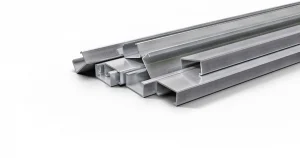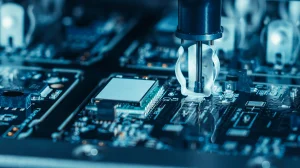
Electroplating is a method of plating metals onto other materials using electricity. It is commonly used to create decorative finishes on metal objects such as jewelry or automotive parts. The process involves immersing the object in an electrolytic solution and applying a voltage across two electrodes, one at each end of the object. This causes ions from the electrolyte to be deposited on the surface of the object, forming a thin layer that is electrically conductive. The object can then be removed from the bath and rinsed with deionized water to remove any remaining electrolyte.
Electroplating has become very important in modern manufacturing processes because it provides several advantages over conventional methods. It is a more efficient and cost-effective way to plate than the traditional method as it allows for higher-quality deposits with fewer defects. This article will explain the basics and some common uses for electroplating.
Table of Contents
The Electroplating Process
The electroplating process is an important part of manufacturing metals and other materials that are typically found in electronics. This process is normally done by applying an electrical current to the metal and having it then spread onto the substrate. The first step in the electroplating process is dipping or immersing the substrate into a liquid solution, which typically contains a mixture of metals, chemicals, and other substances.
The second step of electroplating is called immersion. It involves submerging the electrodes into an electrolyte solution, which are then connected to a power supply, and then connected through the target substrate being plated.
The third step in electroplating is called cathodic protection, which prevents corrosion during plating.
Finally, the fourth step in electroplating is called electrolysis, where an electric current that causes ions to be released into the electrolyte solution.
Electroplating VS Electropolishing
The two processes tend to be mixed. By definition, electroplating is the process of coating a metal object with a thin layer of metal. While electropolishing is the process of polishing a metal surface with an electrical current.
To explain it better, electroplating uses electricity to create a chemical reaction on the surface of the metal object. In contrast, electropolishing uses an electrical current to remove oxidation from the surface and produce a smooth shiny finish.
Electroplating is used for manufacturing parts or components that need to be coated in order to prevent corrosion or oxidation. Meanwhile, electropolishing is used for finishing off products already plated in order to give them an even more polished look and feel.
Pros And Cons Of Electroplating
The benefits of electroplating are many, including increased strength, lifespan, and conductivity of parts. Engineers, manufacturers, and artists make use of these benefits in a variety of ways:
- Electroplating is used in engineering to increase the strength and durability of various designs. You can improve the strength of different parts by using metals like copper and nickel to cover them. This creates a weaker defense against environmental factors like chemical exposure and UV light for outdoor components.
- Electroplating a product makes it lighter while providing a more attractive and shiny look. It is also a very cost-efficient and easy process.
- Electroplating also improves performance in many applications like battery electrodes and steel production.
Nevertheless, the technique has a number of disadvantages, some of which are:
- Electroplating is a relatively expensive process, and it can be difficult to find a facility that offers it.
- It can be a time-consuming process, depending on the size and complexity of the object being plated.
- If not done properly, electroplating can be dangerous. It can cause electrical shocks, and it can also release harmful fumes.
- Electroplating can be environmentally harmful. This is because the process of electroplating involves the use of chemicals and pollutants that can be harmful to the environment.
- It is also not a very good option for large, high-quality objects.
Aluminium Electroplating

Aluminum is a widely used metal in many industries. In order to achieve the desired quality and appearance, it is subjected to various processes. One of these processes is aluminium electroplating, which involves applying a thin layer of aluminum onto a base material using electricity.
The aluminium electroplating process starts with an aluminum substrate being submerged into an electrolytic bath. The bath contains an acid solution that contains aluminum ions and hydrogen ions (H+) while the substrate has metallic aluminum particles on its surface. Once the aluminum particles are in contact with the acid solution, they begin to dissolve and become charged with electrons (e-). This process is known as dissolution-electrolysis-deposition (DEP).
Aluminium electroplating creates a protective, corrosion-resistant layer which decreases corrosion in wet or dry environments.
Materials That Can Be Electroplated With Aluminium
Electroplating Aluminium can be done on various metals, of which we mention:
Electroplating Aluminium On Stainless Steel
Steel is a widely used metal that is strong and durable, but it can also get weak if exposed to a corrosive environment. Many industries rely on steel to ensure the quality of their products. But, steel’s properties change with the strength of its coating, so plating steel with aluminium can help to make sure it remains strong for years.
Electroplating Aluminium On Copper
Copper is a versatile and durable metal, which has been in use for thousands of years. It is used as a conductor of electricity, to carry heat as well as being used in the production of coins, jewelry and utensils. Copper’s ability to resist corrosion makes it an ideal material for a wide range of industries. When copper is being soldered, the base metal layer (copper in this case) often has a second layer applied to it.
Plating Plastic With Aluminium
We use aluminum to make sheets that can be electroplated on plastic. This plating process makes plastic look shiny and feels smooth, just like natural materials such as metal.
Electroplating Aluminium On Glass
The glass industry has been using aluminium electroplating technology for a number of years now. This process can be used to create levels of protection on the surface of the glass, making it more durable and tougher. This is an interesting way to make non-conductive glass conductive. It you’re looking for a conductive surface just dip it in a solution with aluminum salts and use copper or silver electrodes to generate electricity.
Applications Of Aluminium Electroplating
Aluminum electroplating is used in many industries to enhance the appearance and performance of products. Some common examples include:
Automotive Industry

Aluminium electroplating is used in the automotive industry to coat car parts with a thin layer of aluminium to improve their appearance and durability. This layer can be in the form of a smooth or textured finish.
Aerospace Crafting

Aluminium electroplating is used in the aerospace industry to create a lightweight and corrosion-resistant finish to improve airplanes’ strength and corrosion resistance. It works through coating wings and body panels with a thin layer of aluminium to improve the overall appearance and longevity of the material.
Electronics

Aluminium electroplating is used in the electronics industry to produce thin aluminium coatings to improve the quality of electronic parts. It is also used to build up a protective coating on tools that are likely to be dropped into water or corrosive liquids.
Construction

Aluminium electroplating is used in the construction industry to create a protective coating for metal components that can be exposed to corrosive elements, such as fences, railings, and guttering. This process is often used for both modern building materials and older properties that are undergoing renovation. The aluminium coating prevents rust, which is a major problem with these parts of a building.
Home Decor

Aluminium plating is also used for decorative purposes on household items. Some items that may be plated with aluminium include pots and pans, cutlery, water bottles, can openers, and scissors.
